Posted: May 31st, 2009 | Author: Xu Shengxi | Filed under: creative industries | Tags: creative cluster, creative industry, urban spatial structure | No Comments »
Introduction
The term ‘Creative Industry’ was put forward in UK and has grown up in western countries in 1990s (Rossiter 2008). In UK, creative industry is defined as “those industries which have their origin in individual creativity, skill and talent and which have a potential for wealth and job creation through the generation and exploitation of intellectual property†(Department for Culture, Media and Sport (DCMS) 2002). It covers design, art, architecture, advertising, film, music, video and soft ware, etc (UK Creative Industry n.d.). Creative industry is a new form of economy according to its contributes to economic development. Creative industry started in early 2004 in China has established its formal status and outline since the Eleventh-Five Year Plan in 2005 (Rossiter 2008&Keane 2009).
Cluster originally comes from economic field which means “collectivism and cooperation†(Keane 2009, p.221). Creative cluster is the geographic assembling of creative industry and it includes “non-profit enterprises, cultural institutions, arts venues and individual artists alongside the science park and the media centre†(Porter, 1998 & What Are Creative Clusters n.d.). Besides art creativity and economic earning, creative clusters also contribute to the urban spatial structure, which can be understood as the structure of clusters by using urban public space (Anas, Arnott &Small 1997). Urban spatial structure refers to the distribution and integration of urban elements; it means the shadow cast of urban economic structure and social structure (Lin 2004). To some extent, urban spatial structure can be seen as the spatial form of the development of urban social economy (Ma & Chu 2009).
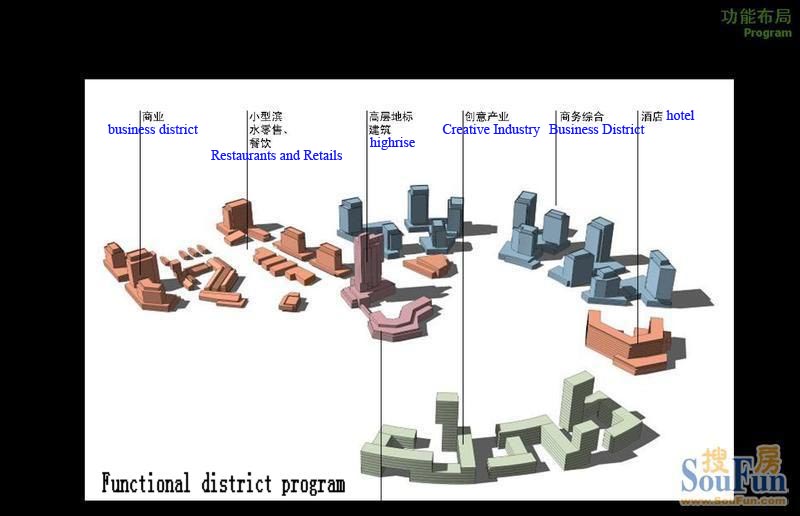
Creative industry develops its early stage in Ningbo; however, it is experiencing a rapidly and sustainable growth (Nie & Wang 2008). The profound economic basis, the supportive policy which proposed in Eleventh-Five Year Plan in 2005 and the long history of commercial manufacture contribute to the development of creative industry in Ningbo (ibid). However, the long-term of “Made in China†brings Ningbo good reputation of Manufacture City but leads to the diversionary embarrassed circumstances which caused by the lack of creative dynamic and independent brand (ibid). Furthermore, perfect creative cluster has not been established in Ningbo because of the lack of creative labour and advanced ideas (Che & Guo 2009).
This paper aims at evaluating to what extent the developments of creative clusters promote the construction of urban spatial structure in Ningbo. Firstly, it examines creative clusters’ effects on adjusting the distribution of urban function districts and the reform of urban structure; secondly, it evaluates the effects on urban economic operation and its contribution to the rebuilding of urban relationship made by the clustering of distinctive industry.
1. Effects on Urban Space
1.1 Adjust the Distribution of Urban Function districts
Michael Keane concludes that “the economic logic of clustering…has been distilled into assorted creative parks, bases, incubators, industrial districts, creative cities, and creative regions†from Michael Porter’s work (cited in Keane 2009, p.226). As Keane (2009) considers creative industry could contribute to create wealth, reconstruct urban space, revamp traditional culture, develop clean service industry and provide more added values. As VanHeur (2009) claims that cluster have impacts on the agglomerations of space. The rise of creative clusters has positive effects on urban spatial structure of Ningbo as it contributes to adjust the distribution of urban functional areas (Che, 2009). The Deputy Director of Standing Committee of Zhenhai District Municipal People’s Congress of Ningbo, Mr. Gao Linxia (2006) points out that it is very important to properly deal with the inter-relationship between urban functions and urban space property in strategy of urbanization. Because it refers to the reasonable arrangement of urban space, the strength of urban functions, the plenitudinous use of urban resources and the improvement of urban efficiency (ibid). Official statistics shows that from 1988 to 2006 secondary industry, commercial manufacture industry, accounts for the most proportion in Ningbo’s economy and the second important is agricultural industry, service industry occupies the smallest proportion (Industrial Structure of Ningbo 2008).
(planning of new districts)
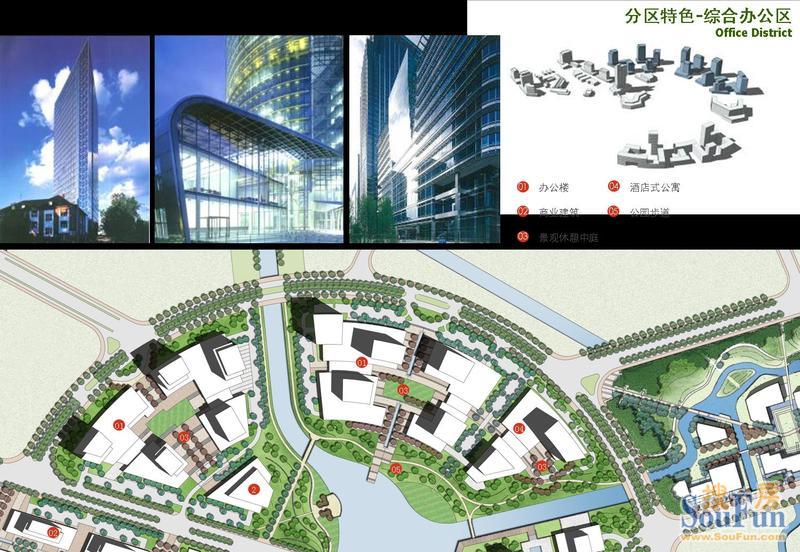
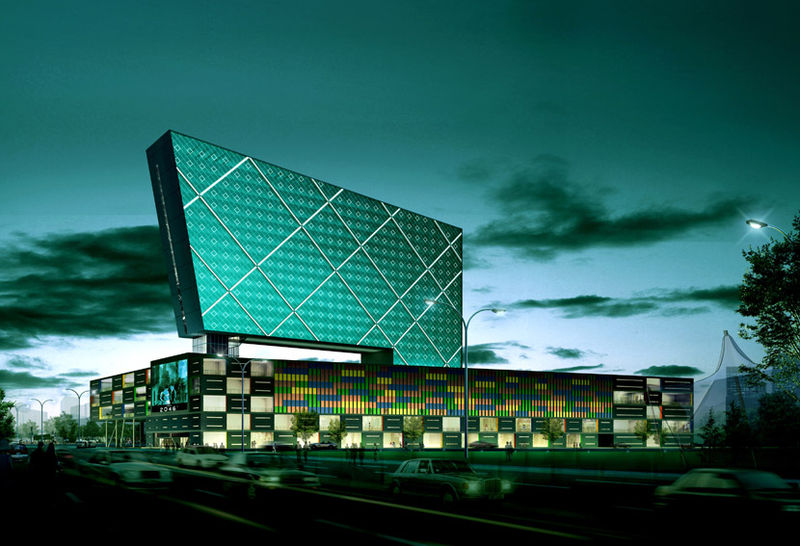
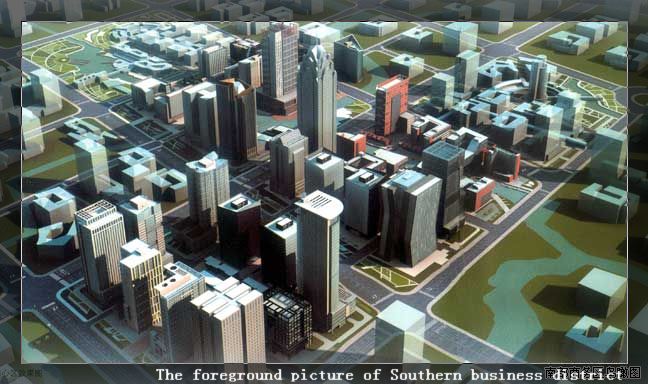
Compare to Shanghai, the advanced creative city of China, Ningbo has inadequate creative labour and market demand (Che, 2009). Creative industry in Shanghai shows characteristics of international, urbanisational and spiry (ibid). In contrast, creative industry in Ningbo is experiencing the early stage. However, Ningbo used to focus on export trade and commercial manufacture, which can become the unique feature in positioning Ningbo as creative industry and innovation undertaking base as they provide abundant economic and cultural foundations (ibid). In nowadays industrialization in Ningbo is experiencing stable increasing periods. Entering WTO brings opportunities as well as threatens to China; therefore, upgrading industries is carried out to response to the challenges (Keane 2009 & Industrial Structure of Ningbo 2008). Moreover, urbanization and industrialization supplement each other. Ningbo government plans to optimize the entire allocation and development pattern of industry (Industrial Structure of Ningbo 2008). The new strategy of urbanization of Ningbo can be summarized as “eastern extension (Dong Kuo), northern combination (Bei Lian), southern planning (Nan Tong Chou) and central upgrading (Zhong Ti Sheng)†(ibid). The core of strategy is promoting the unification of development of industry and district in order to upgrade the integrated strengthen of Ningbo (ibid). The establishment of Creative Technology Park (Chuang e Hui Gu) aims at accomplishing the transition from city-level to national -level through becoming the radiant point of regional independent creation. Additionally, the aim of establishing industrial design street is taking the advantages of Ningbo traditional industry as a reference to cultivate new distinctive district.
1.2 Rebuild Urban Structure
The establishment and improvement of clusters accommodate to the demands of urban development in Ningbo (Huang 2002). It is very important for Ningbo to develop into the economic centre of southern Yangtze River Delta as it is the hinge of traffic and economy in this area (ibid). Not only has the objective requirements of regional economic development, but also Ningbo’s own condition forces it to accelerate its pace of becoming megapolis(ibid). The central city proper of old Ningbo was very small as it assembled along the estuary of the three rivers (Liu & Wang 2004). In nowadays, the estuary of the three rivers has been experienced a tremendous transition of urban spatial structure along with the modification of Old Bund, establishment of urban planning exhibition and opening of Ningbo art gallery. As a result, the primary framework of megapolis has formed and the situation of closed urban functions has been broken down (Gao 2006).
Dr. Guo Jing (2009), the staff of Ningbo Culture and Creative Industry Base in Ningbo Institute of Technology of Zhejiang University, points out that the development of Ningbo urban space is tremendous according to its outlook of master planning. He (ibid) takes the cultural project, book city, as an example. The book city is a non-profit project which is sponsored by local government, additionally; it is located along the estuary of the three rivers, Yuyao River, Fenghua River and Yong River, where was once the location of five rice storage houses (ibid). Such a project which is enormous and invested a large amount of money is scare in the world. In addition, as Mr. Che (2009), the chairman of the director of Ningbo Creative Industry Association, introduces that the northern part of Ningbo city, Ci Cheng, is now growing its creative cluster based on its historical and cultural background. Mr. Che (ibid) emphasises Ningbo should be established as creative city for starting new business, Ci Cheng takes advantages of its outdated building and cultural heritages to explore tourism, meanwhile, there are many handiwork studios arise to contribute to create new undertaking. Mr. Gao Lingxia (2006) points out that the mode of interacting, complementing, collaborative developing among Ningbo central region and circumjacent areas is becoming the new trend of urban development.
1.3 The Deficiency in General Planning
Industrial cluster is adapted and applied by governmental planning since it is considered as a respond to solve the insufficiency of creative clusters agenda (Pratt cited in VanHeur 2009, p.14). The development of creative clusters has an interactional relationship with the general planning of urban spatial structure. On the one hand, Michael Keane (2008) considers the general planning, which is assisted by government, is the core element in deciding the success of creative clusters. Creative industry refers to the trans-boundary integration and upgrade of multi-industries (Kuang & Jiang 2008 & Keane 2008). Government assist the planning of creative space through providing tax preference and legal protection (ibid). In term of Ningbo, old planned economy still has profound effects on managing and operating system, as Mr. Che (2009) mentions that creative industry in China which lack precise and strict definition, even in Beijing, to some extent, will sweep the whole cultural industry into creative industry. Chinese officers prefer to expand the coverage of industry but pay less attention to creative clusters’ integrated ability on districts (ibid). Consequently, Mr. Che (ibid) claims that the extension of creative industry should be decreased but the contents of it should be increased.
On the other hand, in nowadays creative clusters make limited contribution to deploy urban construction despite the progress of urban restructure. Dr. Guo Jing (2009) claims that Ningbo is relatively conservational in culture field; furthermore, the propaganda of creative culture has limited impacts. For example, although the first loft of Ningbo, Loft 8 comprises many design studios, advertising companies and exhibition areas, its propaganda is too weak to integrate the spatial network of its district. Zane Zhu (2009), the host of No Space which is one of the famous design studios in Loft 8, claimed that their exhibition area has limited effect in Ningbo despite they had already successfully held many art exhibitions like paintings and photographs. Additionally, these exhibitions are non-profitable and no relation with commercial activities. Relative limited target audience and no-profitable characteristic causes Loft 8’s inadequate assembly, consequently, it has not contributed enough to urban spatial structure.
2. Effects on Urban Economic Structure
2.1 Adjust to the Operation of Urban Economic Function
Urban spatial structure is the manifestation in space of urban economic structure, consequently, to meet the needs of urban economic operation plays an important role in urban spatial upgrading and restructuring (Lin 2004). Mr. Che (2009) emphasises the growth of economic districts is suitable for the demands of urban economic operation; the positive effects on real estate by the improvement of creative clusters is one of the marked manifestation. To a certain degree the development of creative clusters interacts on the growth of real estate of Ningbo. As Mr. Che (2009) points out that there are four forms of creative clusters in Ningbo: first one is newly established industrial parks such as Creative 128 (Chuangxin 128) of Yinzhou District and Creative Technology Park (Chuang e Hui Gu) of Zhenhai District; secondly, rebuild Creative Park like loft 8 and Hefeng Creative Square which based on disused old Hefeng Cotton Mill; thirdly, commercial creative parks with government support, such as the Industrial Design Creative Street; forth, independent enterprise which leads new brand in its industry in Ningbo, such as Ningbo Tianzhiying Film, Video and Animation Corporation (see the video please cilck here). Mr. Che (ibid) emphasises that all these projects are related to real estate. Keane(2009) claims that the collaboration between real estate developers and government motivate the adaption and extension of creative clusters.
(old building of Hefeng Cotton Mill)
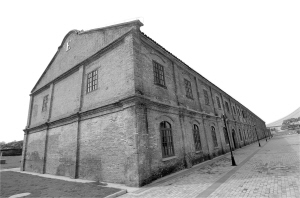
Danny Butt (2008) considers that the value of real estate arose accompany the concentration of artists. It means the entering of creative companies, the development of art activities and the gathering of creative labour contribute to increasing art value of the land (ibid). Moreover, Michael Keane (2009) claims that real estate developers could guide the concentration of creative industry, in addition, gentrification accompanies the emergence of service function for consumption, such as bars, book stores and restaurants. As a result, the used-land for this cluster will increase in value (ibid). Gentrification is a pheromone about urban space, which firstly means the upgrade of urban centre in the process of re-urbanization in western countries (Wetzel 2004). The inflow of creative population in the milieu of Design College and galleries result in the growth of service industry as the international artists require for a utility area to meet their needs for life and leisure (Keane 2009). Therefore, the commercial circulation which based on creative cluster has scabbled.
However, the development of creative industry in China, to a certain degree, is becoming the representative of real estate. As Chen Shaofeng (2008), the assistant dean of Institute for Cultural Industries of Pecking University, claims that there is a mistaken idea in the growth of creative clusters in China. He mentions creative industry is usually operated as real estate program according to governmental policy about land supervision (ibid). It leads to the transition of creative cluster from Creative Park to Real Estate Park, and weakens cultural power as well as distorts the original meaning of cultural creativity though it brings economic profits (ibid). Creative clusters seldom create new ideas; they even become image-program of government (Rossiter 2008 & Chen 2008).
2.2 The Concentration of Distinctive Industry Reform Urban Relationship
The gathering of distinctive industry would promote the rise of enterprises and the improvement of industrial dimensions (Che, 2009). The systematic industry cluster can get access to be the symbol of certain districts and form nationwide radiation (ibid). In term of Ningbo, the first newly creative development zone, Creative Technology Park (Chuang e Hui Gu) which locates in Ningbo University Park, successfully absorbs many advertising, soft ware, animation, industrial design corporations with assistance from local government. Tax preference policy, rewards for research and development motivate investment pour in creative cluster and make it have more dynamic in growth (ibid). Creative industry is related to citied industry and has characteristics of knowledge-intensive. The development of clusters results in positive transition of urban structure. In term of capital investment, it influences anthropology flow because creative industry gathers human ideas and creativities. Adrian Blackwell (2008, p. 48) mentions in today’s China there are two basic extensions mode of urban outer suburbs, which are “poorly controlled village intensification and expansive new development zonesâ€. Rossiter (2008) considers the restructure of various districts will happen in a certain scale. In some cities with development scale of creative industry, like Beijing and Shanghai, the new economic form based on urban historical heritage creates new profits, for instance 798 in Beijing and Tianzi Fang in Shanghai. This kind of urban heritage is labelled history and Chinese characteristics, moreover, they are reformed as the new artistic space for consumption. This kind of creative cluster, which is considered as “a cultural archipelagoâ€, is able to re-mode the relationship among government, enterprises, localite, academics and cultural producers (Blackwell 2008, p.48 & Keane 2009, p.221).
Improving urban distinctive industry has to form its unique industrial position. Conurbation like Beijing, Shanghai and their environed cities in China had already attached importance to industrial position. For example, Beijing has been applying itself to construct the cultural and sporty central which links folk-custom area, fashion business district and Olympic subject construction together; Tianjin, the outer city of Beijing, recurs to the abundant tourist and geographical resource of Beijing to improve urban infrastructure construction; inland cities like Chengdu and Chongqing get help from national western plan in developing creative industrial design; second-tier cities like Hangzhou and Nanjing, which are similar to Ningbo, focus on growing animation, software, design, service and real estate housing for new art creativity which based on disused factories (Keane 2009). Mr. Che (2009) considers the core power of developing industry is commercial promotion; in addition, the formation of urban distinctive industry which is also identified as one of the important system of industrial commercialization, is an economic circulation. Mr. Che (ibid) also introduces that an industrial design street in Jiangdong District is being built and it is a commercial creative park sponsored by governmental institution. Officials plan to compartmentalize an area in downtown and establish serials of separated buildings in order to form natural block (ibid). Mr. Che points out that Tian Zi Fang of Shanghai could be the successful mode for them to use as a reference according to its combination of old alleys and new creative activities, meanwhile, Tian Zi Fang directly links producing and selling as the design studios there are also the places they display their goods. In term of the Jiangdong industrial design street, the downstairs there will be the selling hall and display the products from upstairs, the design zone.
2.3 The Deficiency of Creative Clusters’ Contribution to Urban Spatial Structure
However, in Ningbo relatively mature and large-scale creative clusters have not arose in its primarily develop, which results in urban spatial structure partly registers as unsystematic and dispersive (Che, 2009). The first reason of this phenomenon is severely inadequate of talented people in creative industry. In spite of Ningbo is one of the most important manufacture base, it is weaken in self industrial design (Tang 2008). Even in famous emprises like Ningbo FOTILE Kitchen Ware Co., Ltd, there is an inadequate of professional designer (ibid). Furthermore, creative industry is considered as intellectual property which refers to brainwork of creative labour. The development of creative industry in China based on cultural fundament, including Chinese traditional culture and exotic culture. Dr. Guo Jing (2009) considers it is difficult to integrate Ningbo, such a relatively conservational city in culture, and creative industry, such an industry needs large amounts of new objects and notions. As a result, Ningbo has not finished the establishment of cultural creative industry which contributes significantly to urban spatial structure (ibid). Mr. Che (2009) claims the large-scale clusters and distinctive industry have not formed in Ningbo. Additionally, as culture account for a large proportion in China’s creative industry, Dr. Guo Jing (2009) mentions that the term culture needs a long period for being observed. Since creative industry has been experiencing early stage in Ningbo, it has not contributed much to urban spatial structure (Guo 2009 & Che 2009).
Conclusion
Creative industry has been leading the development of creative economy since its growth in 1990s. In contemporary China, where is experiencing a complicated transition in economic, urban and social areas, government places great emphasis on creative industry as it relates to the development of national soft power. Ningbo is the traffic and economic hinge of Yangtze River Delta. There is a long history of industrial manufacture in Ningbo. Economic basis, geographic condition and future urban planning require Ningbo to develop its creative industry in order to promote the increasing of economy.
Creative cluster is the geographic concentration of creative industry. Urban spatial structure means the distribution and integration in space of urban elements. It represents the spatial situation of urban economic and social structure. Creative cluster in Ningbo is now developing in the primary stage. Under the assistance of Ningbo government, there are four main forms of creative clusters, include new established creative industrial parks, loft, innovation undertaking parks and independent enterprise which leads new brand in its industry in Ningbo.
The development of Ningbo’s creative cluster interacts with the construction of urban spatial structure. On the one hand, the rise of creative clusters adjusts the districting of functional areas, reform the urban structure. On the other hand, urban general planning is the core element of deciding creative clusters succeed or not. In Ningbo, lack of creative labour and creative concept lead to creative cluster has not formed large-scale industrial parks. As a result, creative clusters have limited impact on urban spatial structure in contemporary Ningbo although it contributes to district the functional areas and reform the urban structure. However, Ningbo has potential in developing creative clusters as the support of officials and the economic situation. It is important to focus on the four forms of creative clusters in future research in order to excogitate the appropriate proposal of improving Ningbo creative industry.
References
Anas, A & Arnott, R & Small, K A 1997, Urban Spatial Structure, The University Of California Transportation Center, University Of California At Berkeley. Retrieved may 19, 2009, from http://www.uctc.net/papers/357.pdf
Blackwell, A 2008, ‘Inverting the Cultural Map: Peripheral Geographies of Beijing’s Creative Production’, Urban China vol.33, pp.48-51.
Butt, D 2008, ‘Can You Manufacture A Creative Cluster?’ Urban China. vol.33, p.33.
Carriço, Mónica; de Muynck, Bert; Rossiter, Ned (eds) 2008, [Special Issue: ‘Creative China: Counter-Mapping Creative Industries’],Urban China ,vol. 33.pp.24-25.
Che, Xiao Fang 2009, Interview, 20 May. for those who want his contact details: mobile: 13906680232
Chen, S F 2008, ‘Ten Mistaken Ideas of Creative Clusters’, China high and new technology industrial development zone, vol.3, pp.18. China Academic Journal Electronic Publishing House. 陈少锋,2008, ‘创æ„产业èšé›†å›çš„å大误区’,ä¸å›½é«˜æ–°åŒºï¼Œ2008年第3期,pp.18
Department for Culture, Media and Sport (DCMS) 2002, Creative Industries Fact File, 2-4 Cockspur Street London SW1Y 5DH. Retrieved May 19, 2009, from http://www.culture.gov.uk/PDF/ci_fact_file.pdf
Gao, L X 2006, ‘Deal with the Relationship between Urban Functions and Urban Space during the Development of Urban Centre’, Sanjiang Forum, vol.4, pp.8-11. 高å²å¤ï¼Œ2006,’å®æ³¢ä¸å¿ƒåŸŽå¸‚å‘展ä¸åŸŽå¸‚功能与空间关系处ç†â€™ï¼Œä¸‰æ±Ÿè®ºå›, 第4期,pp.8-11.
Guo, Jing 2009, Interview, 13 May. for those who want his contact details: mobile: 15867390137
Huang,X G 2002, ‘The thought for Ningbo’s developing strategy’, Urban Studies, vol. 9 no. 4, pp.62-65. 黄兴国, 2002 对å®æ³¢å‘展战略的æ€è€ƒï¼ŒåŸŽå¸‚å‘å±•ç ”ç©¶ï¼Œ9å·ï¼Œ2004年第4期,pp.62-65.
Keane, M 2008, ‘Creative Clusters: Out of Nowhere?’, Urban China, vol.33,pp.34-35
Keane, M 2009, ‘Great Adaptations: China’s Creative Clusters and New Social Contract’, Journal of Media & Cultural Studies, vol. 23, no.2, pp.221-230.
Kuang, X M & Jiang J, ‘Prologue: Created In China— Bottleneck and Breaking Through of A Great Country in Industry Transition’, Urban China, vol.33, pp.18-19.
Lin, Y J 2004, ‘The Evolution and Optimization of the Urban Spatial Form of Ningbo’, Modern City Research, vol.12, pp.53-57. 林艳å›ï¼Œ2004, å®æ³¢åŸŽå¸‚空间形æ€æ¼”å˜è¿‡ç¨‹åŠä¼˜åŒ–ç ”ç©¶ï¼ŒçŽ°ä»£åŸŽå¸‚ç ”ç©¶ï¼Œ 第12期, pp. 53-57.
Liu, F L & Wang, R Y 2004, ‘Understanding of Ningbo City’s Urban Construction’, Urban Studies, vol.11,no.3,pp.79-83. 刘å‘良&王人扬, ‘一个城市å˜è¿çš„浓墨é‡å½©â€”——å®æ³¢å¸‚城市建设解读’,城市å‘å±•ç ”ç©¶ï¼Œ11å·ï¼Œ2004年第3期,pp.79-83.
Ma, W B & Chu, J F 2009, ‘Industrial Clusters and the Upgrade of Spatial Structure in Shanghai’, China Urban Economy, vol.1, pp.51-53. 马å´æ–Œ& 褚劲风 2009,上海产业èšé›†åŒºä¸Žç©ºé—´ç»“构优化。ä¸å›½åŸŽå¸‚ç»æµŽï¼Œ2009年第一期,pp.51-53.
Ned, R 2008, ‘Informational Geographies vs. Creative Clusters’, Urban China, vol.33, pp.32.
Nie, J L & Wang Q Y2008, ‘Investigation about Current Situation of Ningbo Creative Industry and Developing Strategy’, Market Modernization, vol.561, pp.213-215. è‚晶磊 &王秋艳, 2008, ‘å®æ³¢åˆ›æ„产业现状调查与å‘展战略’, 商场现代化,总第561期,pp.213-215
Porter, M E. 1998. ‘Clusters and the new economics of competition’. Harvard Business Review, pp.77–90. Retrieved May 19, 2009, from
http://www.econ-pol.unisi.it/didattica/ecreti/Porter1998.pdf
Tang, X D2008, ‘Industrial Design and Developing Strategy of Creative Industry in Ningbo’, Private Technology and Economy in China, vol.231.no.5, pp.38-39. å”先达,2008, ‘å®æ³¢å·¥ä¸šè®¾è®¡ä¸Žåˆ›æ„产业å‘展ç–略’, ä¸å›½æ°‘è¥ç§‘技与ç»æµŽï¼Œ2008年第5期总第231期, pp.38-39.
UK in Taiwan British Trade and Cultural Office n.d., UK Creative Industry. Retrieved May 1st ,2009, from
http://ukintaiwan.fco.gov.uk/en/doing-business/business-investment-in-uk/uk-business-environment/creative-industry/
VanHeur, B 2009, The Clustering of Creative Networks: between Myth and Reality, Urban Studies, vol.46, no.9.Sage Publications Ltd.
Wetzel, T 2004, What is gentrification? Retrieved May 19, 2009, from http://www.uncanny.net/~wetzel/gentry.htm
Zhu, Z 2009, Interview, 14 May. for those who want his contact details: mobile: 13777065961,video please click here
Posted: May 31st, 2009 | Author: Fu Hanqing | Filed under: Uncategorized | No Comments »
Introduction
Within the recent twenty years, developed capitalist countries are in the process of promoting economic structure. As a part of global economy, China is also affected by this change. Now, in China, the most important thing is to change from ‘Made in China’ to ‘Created in China’. Directed by this objective, creative industry has developed to a certain extent. However, as a basic constituent part, migrant workers’ roles in creative industry always ignored. Few people connect migrant workers with creative industry. Actually, as the typical subject of Post-Fordism, highly flexible and unstable of migrant workers fit to the features of creative industry, which is also the typical industry in the era of Post-Fordism, to a certain degree. However, question of what is the relationship between creative industry and migrant workers is arising. In order to discuss the question, this paper regards Ningbo, a second-tier city in Zhejiang province, as an example to analyze the relationship between creative industry and migrant workers in the era of Post-Fordism. The concept of Post-Fordism and its representation in contemporary China will be first presented. The relationship between creative industry and migrant workers will be then examined from three perspectives, with focuses on the creative production and consumption, the spatial distribution and the creative expression.
1. Post-Fordism and Its Representation in Contemporary China
Post-Fordism is a concept corresponding to the Fordism. Based on producing commercial article in a large scale on the production line, Fordism is a mode of production which regards standardized products and low prices as important means in business competition (Braverman 1974). Since 1950s, Fordism has been practiced by western companies generally. As a result, the golden age of capitalist economy occured. However, by the end of 1960s, the environment of world economy had changed, and the inherent disadvantages of Fordism emerged. In order to reply the crisis, developed capitalist countries began to promote economic structure (Alain 1987). In this process, two modes, Neo-Fordism and Post-Fordism, for resolving the crisis shaped regularly (Albritton et al. 2002). In the eye of the development of capitalist countries from 1990s, Post-Fordism represented the developmental direction of the mode of production. Comparing with Fordism, Post-Fordism is a mode of production based on information and communication techniques and to satisfy the individuating demands. And both the process of production and labor relations of Post-Fordism are flexible. Specifically, Post-Fordism includes flexible specialization and lean production. Flexible specialization means small quantity production done by skilled workers takes the place of quantity production on the production line. When consumer’s demand is changing, temporary groups for producing special products may be superseded by other associations. Lean production means companies set up close ties among research, production and sale departments. The innovation in both technology and product is important. In addition, companies should enhance core competitive in main areas and outsource the weak parts of production to other companies, Amin notes (1994).
Although Post-Fordism is used to describe the mode of production in western society, China is affected by it inevitably in the wave in economic globalization. Actually, the representation of Post-Fordism in China is obvious and even special. Now, in China, the transition of traditional industries is in progress. In order to move to a better position in industry chain, originality which can enhance the product added value is paid more attention. In other words, creative industry has become more and more important in the industrial structures in China. Actually, creative industry is a typical industry of Post-Fordism. Firstly, aiming at the various requirements, different creative products emerge in the market. The typical example is fake design. In fact, the invaluable asset of fake design is to satisfy the individuation demands of customers. It will be further discussed in following part. In addition, the various demands necessitated the small quantity and special production. Fake design can also be a good example. Moreover, because of the unstable market requirements, creative companies have to employ workers in a flexible way. Low-skilled workers were gathered and rejected casually. And because of a lack of creative power, Low-skilled workers are classified into low-level labor force, earning little money. (Fusheng & Lei 2005). In China, migrant workers are the main parts of these low-skilled workers. They usually get low-level job like serving for resort, recycling wastes and constructing infrastructures facilities of creative industry. And the employment is also temporary, after finishing the work migrant workers should find new jobs. It should be noted that the feature of no fixed abode helps migrant workers adapt doing odd jobs.
2. The Relationship Between Creative Industry and Migrant Workers in the Levels of Creative Production and Consumption
2.1 Creative Production
In general, migrant workers are considered as in the periphery of creative industry. Neilson (2008) points out that in China, the development of creative industry should be supported by the infrastructure construction. And with the development of creative industry, more businessmen have desire to exploit real-estate in the edge of the city. So, a flood of cheap labor is needed. Ned & Neilson (2008) also indicate large influxes of migrant works solve the problem of the lack of labor force. Of course, migrant workers who have few work skills usually do work in the lower echelon of the creative industry. Their labor is highly flexible. Within some dates, migrant workers may gather together to work in the building site. After building the house, they have to find another jobs, it may or may not building houses.
The example of migrant workers in Ningbo can be a good instance. Shiyong (2007) reports Ningbo is the big producer in manufacturing industry in China. In the era of Post-Fordism, innovation in traditional industries is in the process of transforming in Ningbo. In this process, local labor force is far from the requirement of development, more migrant workers are needed, as. Low-skilled migrant workers always do the low-level jobs in Ningbo, such recycling waste products and building houses (Shuli & Jialiang & Suoping 2008). By researching, the recycling industry is prospering in Ningbo. There are various recycle stations and markets, such as Nanmeng second-hand goods markets, Housun metal scrap recycling market, and Wangchun renewable resource recycling station. A large number of migrant workers work in the recycling industry. This situation is quite similar to migrant workers in other industries. Although migrant workers’ work is not directly related to creative production, they guarantee the operation and development of creative industry.
A Migrang worker carries bricks on his back. Behind him, there is a tall building. ( Yinzhou area in Ningbo)
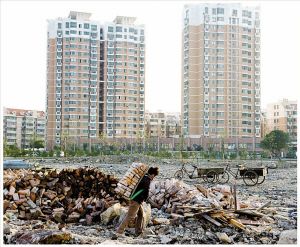
2.2 Creative Consumption
Migrant workers are usually in the low-end of value distribution of creative industry. People think that they do not have the ability to consume the creative products which contain more potential values. The whole imagination about migrant workers’ cultural consumption is connected to the tasteless performance of sings and dances or recreation in the low-grade KTV. Maybe these can be parts of portrayal of migrant workers’ cultural consumption. However, the innovative ability, in both production and consumption, of migrant workers cannot be ignored. Xiaoming & Jun (2008) points out that actually, in the process of transforming from ‘Made in China’ to ‘Created in China’, a very special mode of creation which is called ‘Fake Design’ has appeared. Fake design began in the manufacturing of mobile phone in 2008 and developed in manufacturing of digital products. After that, fake design is popular in various industries. The interesting thing is that the fake design products naturally have the characters of Post-Fordism. The producers of fake design products have broken the mode of quantity production, designing specific products to cater for different needs of customers. The fake design products enabled underclass, especially migrant workers, to afford the creative products. Thus, migrant works are included in both creative production and consumption.
To take Ningbo for an example, fake design products are also quite popular in migrant workers. During the research, migrant workers’ mobile phones which can easily be recognized as the imitation of Nokia, Samsung and other famous brands attract my interests. Liu (2009) told me that he spent 490 RMB on the phone in which the term of Sunsung was printed. Fake design phones make migrant workers look like townsman in some ways. Obviously, without fake design products, they may not use phones because of the high prices.
Migrant Workers & Fake Design Mobile Phone
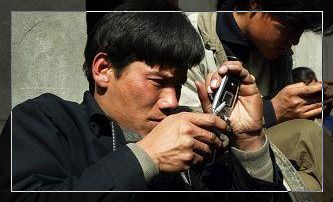
3. The Relationship Between Creative Industry and Migrant Workers in the Levels of Spatial Distribution
The relationship between creative industry and migrant workers in the levels of spatial distribution should be considered from two aspects. The first perspective is about the relation of the geographic distribution between migrant workers and creative industry. Butt (2008) indicates that, on one hand, as the main mode of production of Post-Fordism, cluster production is very common in creative industry. By gathering spontaneously or planning governmentally or developing commercially, creative cluster always distributes in the special spaces in the city. Neilson, & Rossiter (2008) point out that the operation of cluster production needs more supporting infrastructure which can bring more opportunities of low-skilled work. So, a large number of migrant workers are desperate for work crowd in creative cluster. In China, creative clusters gather in both the center and the edge of a city, a large amount of migrant workers also can be founded there. On the other hand, the cost of living is a prime consideration for migrant workers, so they tend to dwell around the creative cluster rather than live far from them. And the liquidity of migrant workers provides possibility for them to move willfully. A common example is that, in China, around the construction site, there are numbers of miserable work sheds in which migrant workers dwell. After building the house, these miserable work sheds are dismantled, migrant workers should move again until to find another temporary job. This process occurs through a cycle.
The second perspective is about the relation of the social space distribution between migrant workers and creative industry. In the era of Post-Fordism, creative industry has replaced traditional manufacturing industry, becoming the principal sector of the economy to some degree in the city (Susan & Gordon & Harloe M 1992). The transformation of industrial structure leads to polarization of the society. People who are in the high-end of value distribution of creative industry chain have become the new elites, such as the designers and the developers of real-estate. People who are in the low-end of value distribution of creative industry are in the lower class of the society, like the migrant workers (Zhigang & Fulong & Hanlong 2004). The polarization of social class also reflects the geographic distribution of different classes in the city. Elite always distribute in the luxury condominium of the civic center and the suburban villa while lower class, especially the migrant workers, usually live together in the urban and rural connecting areas. And they build shanty or lease unadorned houses own by local peasants, characterized by similar native places and occupations.
In Ningbo there are 3 kinds of conditions of the relationship between creative industry and migrant workers. First of all, creative cluster in Ningbo mainly gather in the industrial parks of the periphery of the city, such as ‘Creative Valley’ in Zhenhai area and ‘Innovation 128’ in Yinzhou area, and lofts of the old city town, such as Loft 8 in Haishu area and No.3 factory in Jiangdong area, as Che (2009) notes. The lofts were reconstructed from old factories, surrounded by communities. Migrant workers merely appear in these areas. However, both the ‘Creative Valley’ and ‘Innovation 128’ are located in the edge of the cities. Although, these two creative industry parks operate in the early stage, migrant workers have already assembled in these places. The construction of infrastructural facilities needs more migrant workers. Che (2009) also points out that both of two parks are projects of real-estate. Migrant workers can find more low-skilled work there, such as carrying of bricks and recycling metallic scrap. Secondly, affected by recycling industries, numbers of migrant workers gather in the city villages. City villagers distribute in every sections of Ningbo. A recycling market near the city village can be always found. For example, Zhang (2009) who lives in Housun village in Haishu area of Ningbo told us that he has lived in city village for one year and a half. In the beginning, he and his neighbor were introduced to work here by his villager of Anhui Province. Every day, they collect metal scarp in the metal scrap recycling market near Housun village and do some simple processing. By doing this work, they can earn more money than farming in his hometown. However, he has to move house and find new job, because Housun village are in the process of demolishing. Actually, more city villages, such as Lianfeng villiage and Wangchun village, are in the process of demolishing because of the urbanization of Ningbo. By then, migrant workers may gather in new places which can provide low-skilled jobs (Tiefeng 2009).
Temporary Shanty
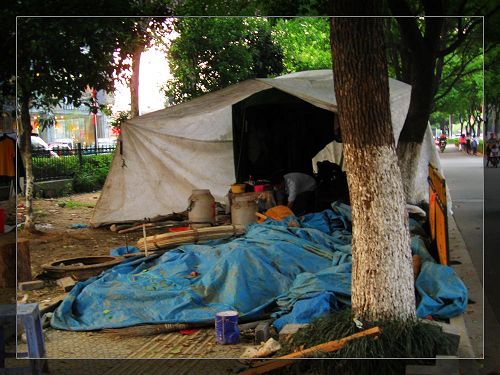
City Village : ‘Wang Chun’ Village

Thirdly, some migrant workers have relatively permanent home in Ningbo. This condition can be found in the creative industries which require some skills. The noticeable example is the textile and clothing industry. In fact, the transformation of textile and clothing industry in Ningbo has happened. Technical innovation was paid more attention to. Thus the requirement of work skills is relatively high. Some migrant workers have the abilities to work in textile mills and garment factories. And their problems of lodging are solved by enterprise. For instance, Ningbo Youngor clothing company, the top enterprises of textile and clothing industry in China, provides dormitories and supporting facilities for both local and migrant workers. The lives of migrant workers who have some work skills are relatively stable and they are called white-collar in migrant workers (Tan 2009).
4. The Relationship Between Creative Industry and Migrant Workers in the Level of Creative Expression
In our established thoughts, migrant workers merely related to the construction of infrastructural facilities of creative industry, the relationship between migrant workers and creative industry in the level of creative expression are not concerned. However, by digging, the deep relationship can be revealed. Guo (2009) indicates that the development of culture needs supporting of a stable and secure environment, while creation can be stimulated in the circumstance of uncertainties and fluidity. Thus, in this respect, the living environment of migrant workers can stimulate some new idea and new practices, no matter whose ideas and practices they are. TO view from another perspective, Blackwell (2008) represents that, migrant workers from different provinces congregated in the urban periphery, creating collisions among diverse experiences, skills and talents. These collisions provided a huge potential for innovation. Actually, the creative expressions, made by both migrant workers themselves and other creative producers, have arisen.
4.1 Self-Expression of Migrant workers
Recent years, migrant workers express themselves through various forms in China. In megacities, autobiography wrote by migrant workers are quite popular. Besides, lots of migrant workers are interest in poetical creation. In the first national poetry competition of migrant workers in 2008, more than 3000 migrant workers took part in the competition and over 20,000 poetries were handed in. All of these works express the state of surviving of migrant workers (They are migrant workers, they are poets 2008).
It seems that it is more possible for migrant workers to be stimulated to give voice to themselves in megacities. However, actually, in the Second-tier Cities, migrant workers are also interested in expressing their life and the methods for expressing are even quite special. In Ningbo, by researching several dwelling places, a general phenomenon is that migrant workers like to use something related to their works to beautify their environment. In Lianfeng village of Haishu area where rubbish collectors assembled, posters peeled from magazines, bottles, and decorations are used to decorate rubbish collectors’ houses. In a house, a dollar bill was stuck to the glass. Weng (2009) told me that he didn’t know which countries the bill belonged to, it was a memento of his life of collecting waste. Of course, these creative expressions are quite simple and their influences are limited, they can be considered as a channel for reading and understanding by other people in the same class and even higher classes (Yue 2008).
Actually, creative expression of migrant workers in Ningbo goes far beyond the simple way, instead, some cultural and artistic groups where members are all migrant workers have been established. Most of the groups perform just for enjoyment, and a few of them perform in public. Two groups named ‘Zhen Hai Art Ensemble’ in Zhen Hai area and ‘Wei Feng gongs and drums team’ in Jiang Dong area had performed publicly for several times (Zui & Yangyu & Yifen 2007). In addition, original painting exhibition drew by migrant workers is on show. The topics of these performances and works always closely related to the life of migrant workers, such as their love life, the housing problems and their expectation of life. Now, their performance has attracted artists and businessmen. Artists want to cooperate with these groups while businessmen desire to push their performances to the market. All of these seem that a creative cooperation crossed the boundaries is about to come forth.
Cultural and Artistic Groups of Migrant Workers
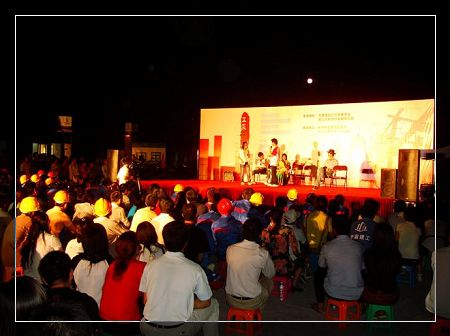
4.2 Concern by Others
In China, more and more producers in creative industry bring migrant workers under the vision of creative expression. Two methods are always used. Firstly, designers add some characters of migrant workers in design. For example, a canvas shoe named ‘Ospop’ is now popular in European and American Market. In fact, this kind of shoes was improved from shoes of migrant workers in daily life. Secondly, migrant workers are taken as the objects for creation. The influential works are photography shows named ‘Frailty and Potential——Flowing at the Edgy’ in Beijing Library in 2006 and the exhibition of work shed in which migrant workers live in Shanghai Biennale in 2008.
Ospop &Â Shoes of Migrant Workers in China

In Ningbo, products affected by the characters of migrant workers do not emerge at the present moment. However, there are exhibitions concerned about the migrant workers. For instance, a photography show of periphery of the city lay out in Ningbo People’s Art Center. When the camera zooms in the tired old dress, the anxious look and low-skilled work, like opening stands and pedaling tricycle, the subsistent state of migrant workers is demonstrated. This demonstration is powerful, helping paying more attention to these bottom people, as Shen (2009), the photographer of the pictures, says.
Although positive evaluations of creative producers’ expression of migrant workers are primary, there are still some negative evaluations. Shi (2009) pointed out that, for migrant workers, the real changes brought by these expressions are slight. Moreover, because of the positions of higher level which creative producers are usually in, these expressions emphasize on displaying creative forms than real contents. Migrant workers serve as a means for revealing innovation. Lei Zheng, the sponsor of a migrant workers literary society named ‘Beijing Work Songs Literary Society’, supports this opinion. And, he also noted that, in this stage, the main glances of creative producers from superior attitudes to migrant workers are sympathetic and curious. (Lei Zhen: ‘Work Songs’ are Needed in This Era 2006). Thus, it is important for migrant workers to express themselves in innovative approaches, and achieving understanding. It may be a contradiction. Creative producers can help migrant workers gain more attention, but they cannot display the real life and emotion of migrant workers. Migrant workers can faithfully representing themselves but the influence is limited.
Conclusion
In contemporary China, creative industry has developed to a certain degree. However migrant workers are considered not relate to the creative industry. Actually, as the typical subject of Post-Fordism, migrant workers play important roles in developing creative industry. This paper takes Ningbo as an example to discuss the relationship between creative industry and migrant workers.
The first section is about the concept and background. The notion of Post-Fordism is first explained. Post-Fordism is a mode of production which is on the basis of information and communication technique and to satisfy the individuating demands. And both the process of production and labor relations of Post-Fordism are flexible. Then the representation of Post-Fordism in China is discussed. It can be found the migrant workers’ characters fitting to the creative industry to a certain extent. The second section examines the relationship between creative industry and migrant workers from the perspective of creative production and consumption. On one hand, large influxes of migrant workers solve the problem of the lack of labor force in creative industry. On the other hand, the fake design products provide opportunities for migrant workers to consume creative inductive. Thus, migrant workers are included in both creative production and consumption. The third section discusses the relationship between creative industry and migrant workers from the perspective of the spatial distribution. The creative industry affects the distribution of migrant workers from both geographic and social levels. The forth section talks about the relation between creative industry and migrant workers from the perspective of the creative expression, other people and migrant workers themselves have different methods of expression. Thus, in the paper, the relationship between creative industry and migrant workers are discussed from these three levels.
It should be noted that, from the subjective aspect, because of the time limitation more researches of literatures and field works of the relationship between migrant workers and creative industry are not done. From the objective aspect, multiple roles and effects of migrant workers in creative industry have not been admitted and the academic studies of them are also limited. Thus the discussion of relationship between migrant workers and creative industry in this paper is not very deep and comprehensive. They could be further researched in the future and of interest to the scholars or other people who are related to creative industry or migrant workers.
References:
‘They are migrant workers, they are poets’ 2008, West China, December 4, p. 15. Retrieved May 14, 2009, from http://wccdaily.scol.com.cn/epaper/hxdsb/html/2008-12/04/content_21093.htm
Alain, L 1987, Mirages and Miracles: The Crises of Global Fordism, Verso, London.
Albritton, R, Itoh, M, Westra, R & Zuege, A 2002, Phases of Capitalist Development: Booms, Crises, and Globalizations, Palgrave Macmillan, London.
Amin, A (ed.) 1994, Post-Fordism: A reader, Blackwell, Cambridge
Blackwell, A 2008, Inverting the Cultural Map: Peripheral Geographies of Beijing’s Creative Production, Urban China vol. 33, pp. 48-51.
Braverman, H 1974, Labor and Monopoly Capital: The Degradation of Work in the Twentieth Century, Monthly Review Press, New York.
Butt, D 2008, Can You Manufacture a Creative Cluster?, Urban China, vol. 33, pp. 44-47.
Che, Xiao Fang (2009). Â Interview, 20 May.
Fusheng, X & Lei, H 2005, Fordism, Neo-Fordism and Post-Fordism: On Evolution of Production Mode in Developed Capitalist Countries, Teacing and Research, vol. 8, pp. 36-42.
Guo, Jing (2009). Interview, 13 May.
Lei Zhen: ‘Work Songs’ are Needed in This Era 2006. Retrieved May 20, 2009, from http://gb.chinareviewnews.com/crn-webapp/doc/docDetailCreate.jsp?coluid=0&kindid=0&docid=100216247
Liu, Chao (2009). Interview, 7 May.
Neilson, B 2008, Labour, Migration, Creative Industries, Risk, Urban China, vol. 33, pp. 42-43.
Neilson, B & Rossiter, N 2008, Precarity as a Political Concept, or, Fordism as Exception, Theory, Culture and Society, vol. 25, pp. 51-72.
Rossiter, N & Yue, M 2008, Migrant Workers, Collaborative Research and Spatial Pressures: An Interview with
Meng Yue, Urban China, vol. 33, p. 33.
Shen, Yi Ming (2009). Interview, 7 May.
Shi, Yang 2009, I cannot Image Migrant Workers’ Life without Going Deep among Their Life. Retrieved May 20, 2009, from http://www.zgnmg.com/gb/news/renwu_detail.asp?id=2548
Shiyong, Z (ed.) 2007, Ningbo Industrial Annual Report, Ningbo Committee for Economic
Shuli, F & Jialiang, Sun & Suoping, G 2008, Characteristics and Roots of Migrant Workers’ Lives in Ningbo, Agriculture, Village and Peasant, vol. 5, pp. 70-72.
Susan, S & Gordon, FL & Harloe M (ed.) 1992, Divided Cities: New York and Affairs, Ningbo.London in the Contemporary world, Blackwell, Oxford.
Tan, Yi (2009). Interview, 13 April.
Tiefeng, X 2009, Methods for Rebuilding City Village in Ningbo, Retrieved April 15, 2009, from http://www.zgnmg.com/gb/news/renwu_detail.asp?id=2548
Weng, Xin Gen. Interview, 5 May.
Xiaoming, K & Jun, Jiang 2008, Prologue: Created in China: Bottleneck and Breakthrough of a Great Country in Industrial Transition, Urban China, vol. 33, pp. 14-19.
Zhang, Guo Liang (2009). Interview, 13 April
Zhigang, L & Fulong, W & Hanlong, L 2004, Social-Spatial Differentiation in China: A Case Study of Three Neighbourhoods in Shanghai, Spatial Differentiation, vol. 28, no. 8, pp. 60-67.
Zui, Chen & Yangyu, L & Yifeng, D 2007, Cultural and Artistic Groups of Migrant Workers are Everywhere Now. Retrieved May 12, 2009, from http://zjnews.zjol.com.cn/05zjnews/system/2007/10/23/008906798.shtml
Posted: May 31st, 2009 | Author: Yao Xiao Xiao | Filed under: real-estate | Tags: advertising, middle class | No Comments »
Introduction
In her article ‘private homes, distinct lifestyles’, Zhang (2008) argues that the rise of the commercial real estate industry in China is vital to the formation of a ‘new urban middle-class’ culture. On the one hand, the private homeownership reflects class difference to some extent, as Li Zhang said, an ‘index of status’. On the other hand, a ‘class milieu’ is also being created and influenced by the privatization of living space. I agree with her argument that in China nowadays, there has not emerged a distinct class culture shared by those so-called ‘middle class’ in economic aspect. Class making in China will be a ‘long and confusing’ process.
In current Chinese society, house is no longer merely a sweet place for family being together, but also a vital representation of one’s social status. As Zhang (2008) points out, the stratification of urban residential space provides a tangible place for people to seek status recognition and create their cultural milieu. As the new rich in China succeed economically, they still lack a sense of social insecurity and yearn for respect from others. Therefore through the consumption of private property, the invisible socioeconomic differences are externalized. Besides a demonstration of one’s wealth, spatial location is also considered as an implication of one’s lifestyle and taste, at least that is what real estate advertising tells people.
Zhang (2008) considered the real estate developers in China are not only selling the house to people but also constructing new notions of ‘the middle class’, especially through advertising. By investigating a number of advertising of housing in Ningbo, this essay will explore whether there exist a distinct so-called middle class culture conveyed by real estate advertising.
Deng Xiaoping’s reform and opening up policy which was started in1978 has brought China tremendous economic development and remarkable social transformation. There were dramatic changes and rapidly rising urbanization rates in China’s cities as a result of globalization and mercerization. The adjustments of China’s economic structure, the large-scale expansion of the tertiary industry and the acceleration of urbanization process have led to the emergence of a Chinese middle class. There was never a clear definition about the middle class in China. A report by National Bureau of Statistics of China once pointed out the standard of middle class in China is “With a household income of 60,000 to 500,000 RMBâ€, but they denied it soon after because of the sensitivity of the topic.
If only take economic income into consideration, different cities will have different standards due to the unbalanced regional development and consumption levels among Chinese cities. Therefore it is impossible to judge middle class only by incomes. Take Ningbo for example, a long history of doing business makes Ningbo a more commercialized city. Private entrepreneurs and merchants account for a relatively larger part. There are also numerous migrant workers with lower education levels doing labor work or small business. They are working very hard and due to the good business environment in Ningbo many of them may earn money beyond the average level of common white collars. They may have reached the economic standards of middle class but their social status is in a low place due to their occupations. And what is more important is that they do not have a concept of consumption. They earn middle-class money but live a low-class life because they prefer to save money rather than consumption. Therefore, Occupations, consumption habits, educations should also be taken into account when referring to middle class.
With a widening income gap, China has witnessed a rise of an urban middle class that has increasingly become the leading force for consumption, accelerating the nation’s consumer power in the world. Housing, cars, leisure, travel and fashion are the key items of the new consumer society, and form the core socio-cultural dimensions of China’s urban development from massive shopping malls, bar areas, theme parks and suburban housing estates to fantasy architectural and urban expressions.(Zhang 2008)
Generally speaking, China’s middle class should be such a group of people: they have decent jobs with incomes that no less than the average level so that they do not have to struggle to make ends meet. They own houses (although on mortgage), cars, stocks and other movable or immovable property. They live a relatively decent life compared to those live in the bottom, but far from the living standard of the affluent class. They are eager to live a better life with less money and place great emphasis on the quality of life but are more rational than the affluent class in terms of consumption habit.
Since the early 1990s, real-estate industry has experienced a big boom due to widespread economic and land reforms. Then the housing reform in 1998 makes house no longer a welfare item provided by work unit, but a commodity (they are called ‘consumer housing’) can be owned privately by the masses. According to recent surveys by the Sohu.com website, real estate has become the most profitable industry in China with more than RMB2.5 trillion currently invested. Cities already account for 75 percent of china’s GDP and this is expected rise to 90 percent by 2025 (Liauw 2008). As an important pillar industry of China’s national economy, the last decade has seen an unprecedented prosperity of real estate industry in China. The enormous potential profits in China’s property market have led to a rapidly expanding of real estate industry. The residential property price, take Ningbo for example, has increased about five times in the last ten years. On the one hand, real estate industry plays an important role in China’s economic development and is a major source of local governments’ tax revenues. Super-scale real estate development project was considered by Zhou (2008) as one of the modern utopian visions in China, along with skyscrapers, mega-structures and super-wide roads, being the political gain of government rather than mere marketing. On the other hand, the private residence price is far beyond the economic capacity of ordinary people. With rocketing property prices in urban China, it is very difficult for middle and low income citizens to afford a decent house. It usually cost a people’s life savings to purchase a house of their own.
Despite how expensive it is, owning a house is still considered as a “must†in the concept of majority Chinese people. For example, it is difficult for a man without a house to find a satisfying wife. House is considered as an essential element of marriage in nowadays China, thus the emergence of “Fang Nu†(‘slave of house’ in the Chinese language), which means one bought a house with a mortgage for 20 to 30 years and almost the rest of his life are working for paying the debt. While the affluent class buying villas or townhouses (usually more than one) with cash, the urban middle class can only afford a flat with mortgage for several tens of years. Furthermore, we are living in a world flooded with house advertising made by real estate developers, which created an illusion that you will live a happy and honorable life as long as you buy a house. ‘Nobles’, ‘elite class’, ‘new rich’, ‘the few’ ‘new gentleman class’ are the most frequent words in those advertising to represent their targeting group. Most of the time we do not see any house in a house advertising but wines, violins, ballet, golf, elegant ladies in evening dresses and gorgeous parties, all the symbols of a classy lifestyle.
The real estate advertising I analyzed here are mainly from the 7th China International Housing & Furnishing Exposition (CHFE) held in April 2009. CHFE, which is held in Ningbo International Conference and Exhibition Center twice a year, exhibits products of real estate, building materials and housing decoration etc. CHFE displays the latest achievements and development and to a great extent reveals the trend of the industry. This time, About 20 real estate developers exhibited their products there, most of which are for residential use. The type of residences range from 40 m2 apartment to 300 m2 villas, but most of them are flats between 90 m2 to 140 m2, which are targeted at the middle class.
By looking at the real estate advertising at the 7th CHFE, I find that there are flooded with western elements. Some are full of images of western faces. Some buildings are portrayed as British style, Spanish style or any other foreign architectural style, even straightly named as Residence of the North Europe. Some are claimed as designed by foreign architects. For example, advertising by the project Art Deco reads, ‘the landscape is designed by Hassell of Australia’. ‘British-style butler service’ is also a very popular word among those advertising. Western lifestyle has always been considered as a superior lifestyle by Chinese people and Euro-style is currently one of the popular architectural flavors. Just as Liauw (2008) points out, the emerging patterns of urban consumption such as mixed-use Central Business Districts (CBDs) or European-themed suburban villas–the new lifestyle aspirations of new middle-class workers–represent ‘a deeper-rooted “coming out†of Chinese urban pride that demands ever more spectacular and different architectural designs’. The westernization tendency could also be observed from their exhibits. Most of the real estate exhibits were decorated luxuriously with western style. Pianos and violins are played there showing an upper class lifestyle. The most impressive scene to me is that a girl played piano in an exhibit corner decorated with classic western elements: oil painting, plaster model and fireplace.
It is also interesting to find out that almost all the real estate billboards are ‘bilingual’. Every project has an English name. Some are not really English, but just Chinese ‘Pinyin’, which is made of English letters so looks like English. Apparently, they are not going to sell those houses to foreigners, because English is more a decorative thing here to make the advertising a superior look. Some are full of spelling and grammar mistake that even British people may not understand the meaning. Such as ‘Rice picked 6 big empty living room, guests also glory’. (Apparently the education level of the advertising designers is not high. In fact, I have already found out that the general quality of real estate advertising in Ningbo has lagged far behind big cities like Shanghai no matter in terms of creativity or concept. Ningbo is making advertising that Shanghai made several years ago. Suddenly I realized that real estate advertising is a good combination of creative industry and real estate industry. I can know about the quality of people working in creative industry from real estate advertising.) Back to the topic, some English sentences are in very small font that people can not read at all, just knowing they are English letters. Some sentences are totally irrelevant to the advertising. The most ridiculous one is on a billboard by Ningxing City Garden, which reads ‘you changed your master’s degree…from computer science to…so you could participate in…’ It seems like the advertising designer randomly picked it from somewhere just to decorate the advertising.
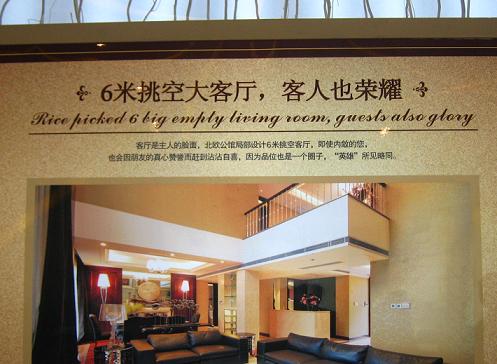
The other popular selling point real estate developers want to convey to their potential customers is an honorable lifestyle, which is also embodied in the name of the projects, such as ‘Top Town’, ‘The Center of Top Class’, ‘Crown Garden’, etc. Five-star treatment, British-style butler service, honorable, luxurious, glory, royal are the most used words. Take a project called Jiangnan Yinpin(First Rank) for example, which is one of the largest complex real estate projects in Ningbo. Its products include high-end residential apartments, office buildings and business streets, with targeting group of middle and upper class. The areas of its residence range from 40 m2 apartment to 410 m2 they call Monolayer, but interestingly, all the residence are called Villa or surpass the villas in the advertising, even it is just a small 40 m2 apartment. For example, ‘40 m2 a persons villa’, ‘89 m2 first rank loft villa’, ‘264 m2 high rise countyard (courtyard) garden surpass the villas’, ‘Top-layor (layer) garden villa with a(an) atrium pool’.

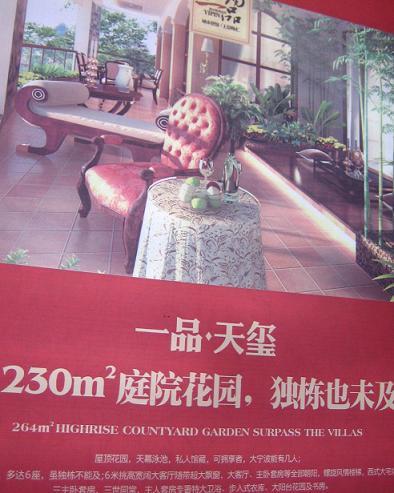
There is another selling point that can not be ignored, that is being close to nature. Garden is the most frequently used word whether in the name of projects or in the advertising. ‘Spring Garden’, ‘Lake View Garden’, ‘City Garden’, ‘Nine Scenery Garden’, ‘East Splendid Park’, ‘Crown Garden’, etc. Houses are usually beautifully portrayed with blue sky, clean water, lovely birds and green gardens. Those advertising are designed to cater for the urban middle class’s desire of being far away from the noisy city and growing thirst of a peaceful life.
To sum up, the real estate advertising in Ningbo clearly conveyed three distinct aspects of middle class culture: longing for a classy lifestyle, western worship and a desire for nature. On the one hand, the middle class are eager to demonstrate their social status by consuming a decent house. On the other hand, they also want to be distinguished from the affluent class which usually being considered as with less education and taste. They are eager for a top class life without having a clear concept of what a top class life really is. Then numerous advertising keep telling them what the top class life should be by creating a utopian world.
References
Liauw, L 2008, ‘Leaping forward, getting rich gloriously, and letting a hundred cities bloom’, in L Liauw (eds), New urban China, Wiley, London, pp. 6-15.
Zhang, J 2008, ‘Urbanization in China in the age of reform’, in L Liauw (eds), New urban China, Wiley, London, pp. 32-35.
Zhang, L 2008, ‘Private Homes, Distinct Lifestyles: Performing a New Middle Class’, in L Zhang & A Ong (eds) Privatizing China: Socialism from Afar, Cornell University Press, Ithaca, pp. 23-40.
Zhou, R 2008, ‘Leaving utopian China’, in L Liauw (eds), New urban China, Wiley, London, pp. 36-39.
Posted: May 31st, 2009 | Author: Shui Jing | Filed under: creative industries, theory | Tags: Ningbo CI | No Comments »
Essay Title: What do the features of spatial clustering mean? Evaluating with references such as Van and Keane to discuss the situation of creative industry in Ningbo and how Ningbo’s clusters connect with urban development.
Introduction
Generally speaking, cluster phenomenon is a universal law in creative industry. It is normally depending on urban function and conveniences of the city. On one hand, city provides perfect infrastructure, cultural and entertainment facilities to enhance creative industry. Relying on these facilities city can create keen culture features to creative class, whom have received more opportunities both on career and residential environment. On the other hand, city could be more attractive and competitive depending on creative industry. Van (2009) also seems to prove this; he says that developing the creative industry cluster is the tendency to reinforce capital accumulation. It is the only way to raise urban competitive power. Scott (2000) shows that when some similar firms or companies aggregate together, they could take advantage from each others.
Historically, Ningbo is a city with 7000 year history. It has been an important seaport for foreign trade as starting point in the Silk Road of Tang Dynasty. After the Opium War, Ningbo port has been regarded as one of the trading port once again. At present, Ningbo as a developed second tier cities in China, it has been received more attention from Chinese government (on political).In addition it is also the group under The Cultural and Historic Planning which is organized by Chinese Ministry of Culture (on economics) because of its long history (Ningbo Overviews 2008).
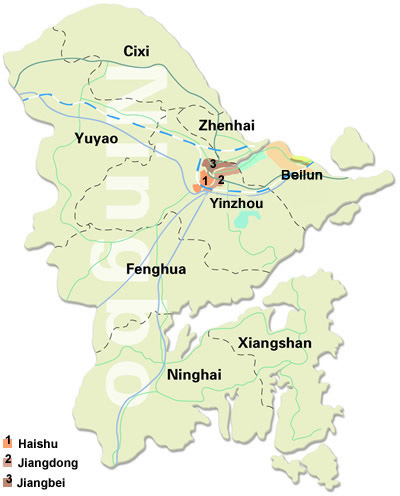
Map of Big Ningbo
According to Wang (2009), in spite of economic crisis around world, GDP in Ningbo raised over the first quarter of 2009. Among this statistics, the primary industry has increased about 1.9%, the secondary industry has decreased nearly 3.7%.However, the tertiary industry rises 7.2% compared to same month last year in the Ningbo Daily (23 April 2009,p.1). It’s seems indicated that creative industry in Ningbo have started to play an important role due to creative industry could assume as part of tertiary industry.
Normally, the definition of creative industry is regard as intellectual property such as music, design, book and game etc. In addition, several creative services also could belong to creative industries which contain advertising, public relationship and so on (DCMS 2001).However, Che (2009)Â (video)who is the director of Ningbo Creative Industry Association holds different opinion. He says that, in Ningbo, the definition of creative industry should narrow down because of the status of Ningbo creative industry at the moment. He says, creative industry in Ningbo could be part of cultural industries and serve the Ningbo manufacturing industry. In addition, at present, Ningbo creative industry can shape up as creative industry business incubator due to the long history of go into business in Ningbo. It is quite different from the creative industry in Beijing today (Che 2009). In Beijing, creative industry seems to stand for anything, because the definition of creative industry in Beijing is expanding a lot. Usually, it connects with politics because the Beijing is the central of politic in China.
Spatial clustering of creative industries also has been highlighted during these days. It is a term from geographic sector. Nowadays, people use this term to explain that huge amounts of related enterprises, studios and organizers gather together for gaining greater competitive power.
This essay divided into three parts. Firstly, characteristic of creative industry in Ningbo will be examined by using Keane’s and Van’s references etc. In addition, some cluster of creative talents in Ningbo will be discoursed. Finally, it will state some weakness and measures of creative industry in Ningbo.
Main body
The present situation of creative clusters in Ningbo
In 2000,Ningbo government put forward a proposal named Sanjiang Culture Corridor, which included Ningbo Grand Theatre, Ningbo Concert Hall, Ningbo Museum, Ningbo Art Gallery and Ningbo Book City. At the same time, Ningbo invested nearly several millions to develop the program; and this was the first time Ningbo Government invest such huge amounts money in culture field (Cai&Guo 2008). Since 2006, Ningbo government has started to concern on creative industry (Chen 2009). It is worth notice that the Eleventh Five Year Plan from central government has promoted Ningbo government decision. This Plan points out that, Chinese government should encourage developed cities and cities with talents on creative to expand their creative industry in the range of culture, science, technology, film production, music production, fashion design, animation, games etc. Simultaneously, integrate creative contents into the traditional business. That is to say, China wants to anticipate creative industry to stimulate their service industry and manufacturing sectors. Ningbo is one of such kind of cities that exactly adapts these conditions. In 2006, Ningbo government announced a series of policies and plans. Some governmental reports from Ningbo government show that developing creative industry is urgent. Firstly, the old districts in Ningbo are unable to mark out or develop the traditional industry because of the shortage of land resources. Secondly, manufacture and foreign trade are the leading industry; if this city wants to achieve bigger competitive power they need change (Cai&Guo 2008). Wang (2006) suggests that the manufacturing advantage is lost in China gradually; people need to look for the new growth point to go ahead. And creative industry could provide with innovation and Ningbo brand. Keane (2009) seems to support this point; he says that recently under the powerful support of Chinese government, the cities may take advantage of creative industry. Some ‘value-added’ phenomena happened on renewal of traditional resources, redesign of urban space and the most crucial one is wealth creation. For example, in Ningbo, the stationery industry accounts for 70% with the number of 4000. The output value is about 50 billion RMB (Zhou 2008).However, there are nearly 80% companies are OEM. It is not a good phenomenon to develop one city. In 2003, one of stationery companies in Ningbo was named Deli Group (Their annual sales were just 300 million before 2003). Until 2004, they decided to changes from their packing design and ask for help from an industry design company in Shanghai. After five years, their sales has increased about 5 times even under attack of economic crisis their annual sales still exceed 1500 millions. It is illustrative that creative industry makes benefit to the company hugely. This also makes Ningbo government to think over the term of creative industry.
On the other hand, awareness of creative industry among the public also has been raised. For example in Ningbo, Zhoushan is a city on the island, besides the islands that residents lived; they also wish to rent rest of islands as creative industry park (Bao 2009). It is an idea which people would never concerned before, until Ningbo government treasure this issue lately. One thing which should be highlighted is that, Ningbo needs to develop these creative clusters depending on the city creative potential and advantage. Lorenzen& Frederiksen (2007) also seems to support this point, he says, economic potential should be concerned when deciding to develop creative cluster.
According to Hu (2009), small scale manufactures in Ningbo has developed very well. However, the reality is that their ability is limited due to the lack of industrial design skill. Therefore, in such situation, design studios in the creative clusters will definitely have closed relationship or location with these enterprises. In other words, small scale manufactures could benefit from design and their products appearance will be showed in creative industry park. In the end, products will get great demand. On the other hand, design studio also could demonstrate their strength and gain money through these design.
Up to May 2009, according to Ningbo Daily (25 May 2009, p.1), Ningbo government is planning to construct at least 10 creative industry parks around the Ningbo city; each district will have at least one creative industry park. At present, most of creative industry park are not completed yet. However, it can still be proved that, the rudimentary creative industry clusters are turning up now in Ningbo.
Another important phenomenon of creative industry park in Ningbo is that creative cluster is totally different from cluster in UK and Germany. In Ningbo, artists and studios get together under governmental policy but UK and German assembled by them voluntary (Van 2009).
In addition,Van also uses Maskell(2001) notes to analyze cluster and development in creative cluster, the one is that some firms are willing to relocate or partly relocate into cluster for potential customers in such area. In China, it can be seen, creative industry park functions the exact same as overseas parks. Therefore, whether this cluster phenomenon is arranged by government or not, the effects and benefits could still been forecast. For example, according to Guangming Daily one of the architectural design relocated into Loft 8 achieved 29 million yuan business volume until 2009 April (30 May 2009,p.3).
Van (2009) says, the functions from creative clusters are concentrating on real estate markets. In the other words, creative industry clusters are used to flourish this market. Additionally, Keane (2009) also divides creative clusters into three modes in China based on landed estate.
The first mode is the most common pattern around the word. That is to preserve the old factory (Keane 2009). Sometimes it is to help the bankrupted firms and sometime is just for protecting some heritage buildings. To some extent, it has not only retained historical building, but also stimulated the imagination of artists. Loft 8 in Ningbo is the vivid case to present this. Loft 8 was Ningbo Fangxiang Factory before. In 2006, this factory had been shut down; at the same time it became an enormous antique in Ningbo. For this reason, Ningbo government has decided to reform this place into creative industry park. One thing should be noticed is that Loft 8 is the first Loft form creative industry park in Ningbo (Cao&Ding 2008). Due to this, it is the first times for Ningbo to establish a creative industry park, and real estate developer of Loft 8 creates some fun. Take an example, as Fangxing Factory was constructed in 1950s, there have been many slogans on the wall of this old factory. The most representative are VIVA, Chairman Mao etc, from Culture Revolution. Developer assumed these slogans are totally useless, therefore they ask for workers to whitewash them. However, the consumers think, these slogans should be keeping back to memorize this history and could highlight studios style. Finally, Loft 8 real estate developer has to flush these covering slogans by using high pressure gun. The manager said they want pay out good-hearted but inept efforts to help. Another similar case in Ningbo includes 238 Creative Park and Sanchang Fasion Creative Block etc. They both transformed from old factories. From the point of view of Keane (2009), through the operation by real estate developers, creative cluster has embodied their real value in well organized on old buildings and city planning. It could be concluded that on one hand, transforming the old building could relieve the financial pressure from government; on the other hand, it also improves regional economic benefit.
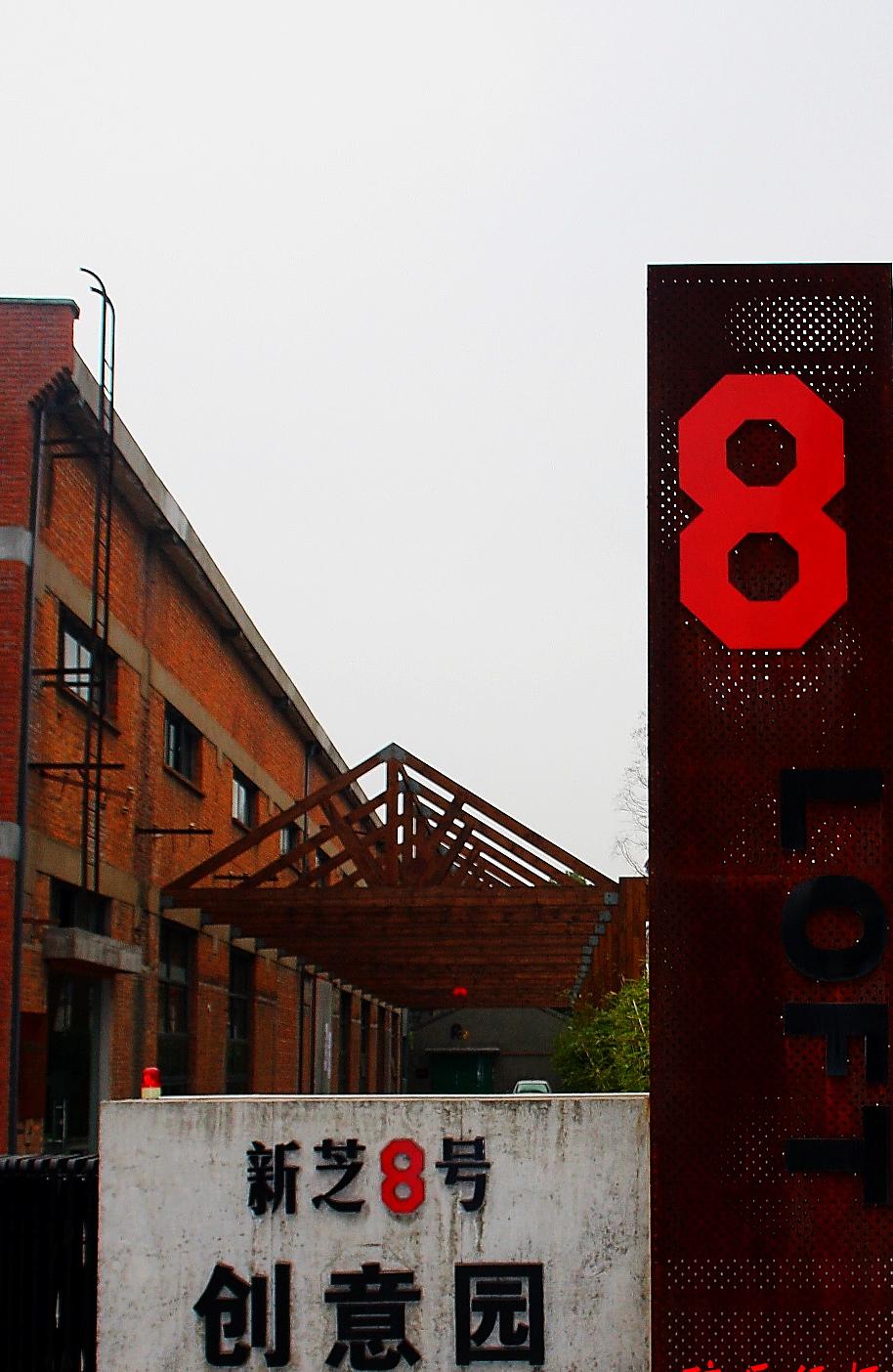
Ningbo Loft 8
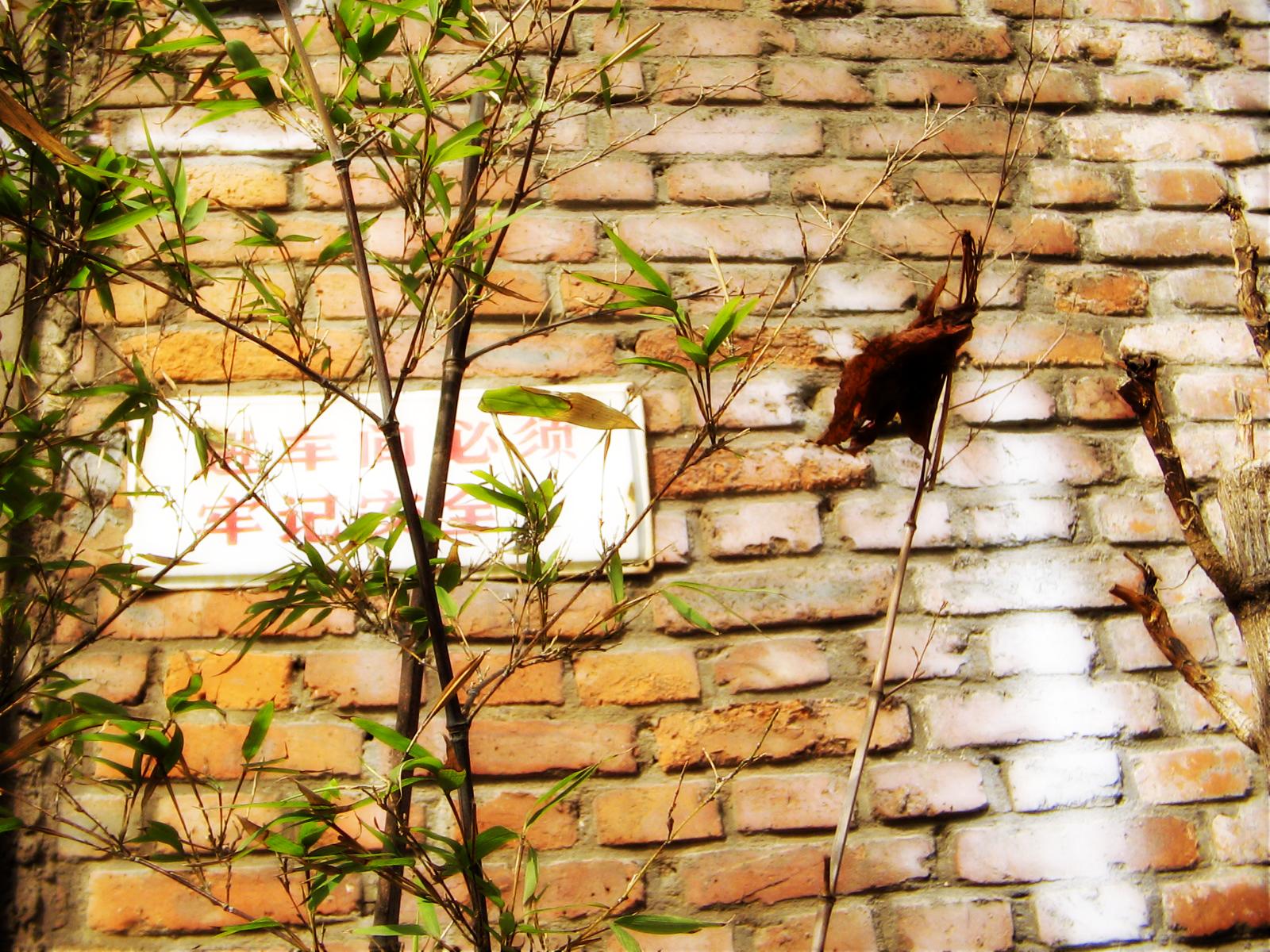
One of slogan in Loft 8
The second mode is the creative industry parks which are constructed with completely new (Keane (2009). Generally, it is driven by government policy in China. This mode is also extremely wide spreading in Ningbo. Take 128 Innovation Valley for example. Government wants to draw on the experience from Boston Route 128 (Actually, I don’t think Boston Route 128 is a good name and experience for this innovation valley, because Boston Route 128 was downfall many years).This innovation valley is funded by an Australian company nearly thirty million dollars. Nowadays the first stage construction of 128 Innovation Valley has been finished and 27 enterprises have moved into this innovation valley. Some Ningbo News reports that the 128 Innovation Valley will be a base for creative industry, industrial design and technology incubator.
The last cluster mode is that some creative industry parks close to the university (Keane 2009). That is also the reason why the central of software industry is in the Ningbo Zhenhai district. Plenty of universities are located there such as Ningbo University, Ningbo Engineering Institute and Ningbo Textile Engineering Institute. Zhenhai district owns the biggest software base named Innovation Valley .
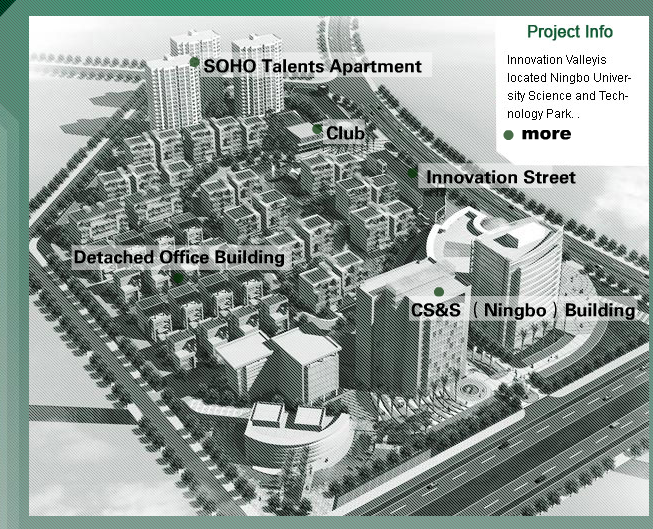
Innovation Planning
The last cluster mode is that some creative industry parks close to the university (Keane 2009). That is also the reason why the central of software industry is in the Ningbo Zhenhai district. Plenty of universities are located there such as Ningbo University, Ningbo Engineering Institute and Ningbo Textile Engineering Institute. Zhenhai district owns the biggest software base named Innovation Valley. According to Ningbo government’s work report, the first-stage construction of Innovation Valley includes three sectors. They are Science Tour, East China Software Outsourcing Service Base and Innovation Valley Research and Development Building. The second phase of the project consists of Software Department of Peking University Ningbo Branch and Northern Europe Industry Park etc. Until now, some international enterprises have entered into this park, such as Det Norske Veritas and IQSS etc. Government report also illustrates that the cluster effects were revealed obviously in 2008.Innovation Valley has achieved output value about RMB 14.17 billion because of the cluster management. Furthermore, it is clearly that Ningbo government pays huge attention to industrial design and software. At present, they also exploit animation industry in Beilun district under the government’s support to industrial design and soft ware. As is known to all that Beilun is one of the important harbours in the world. However, it seems that this district is short of economic growth mode except of this port. Ningbo Vocational and Technical College in Beilun district has started to corporate with famous companies and Shanghai Animation Film Studio to develop animation industry and already get great achievements. Ningbo Daily states that the profits from animation outsourcing service reached to the 900 million yuan until 2009 April (2 May 2009 p.4).
Besides these three types, one thing should be noticed is that, normally, most of creative clusters not only include studio but also include some service companies’ service for the exhibitions and business transactions from artists themselves (Maskell 2001). For example, in Loft 8, studio named No Space is such a company concentrating on both design and exhibition. Yao (2009) says they put up a perfect bridge between artists and art collectors. They try to use their professional knowledge to help provider and customer. Furthermore, urban development enchased the floating of capital, talents and technologies. Those essential factors finally shaped spatial aggregation and made greater benefits.
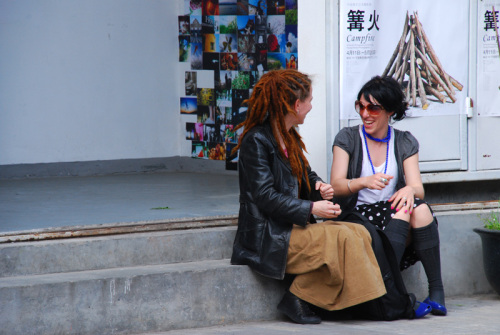
One of photography show in No Space
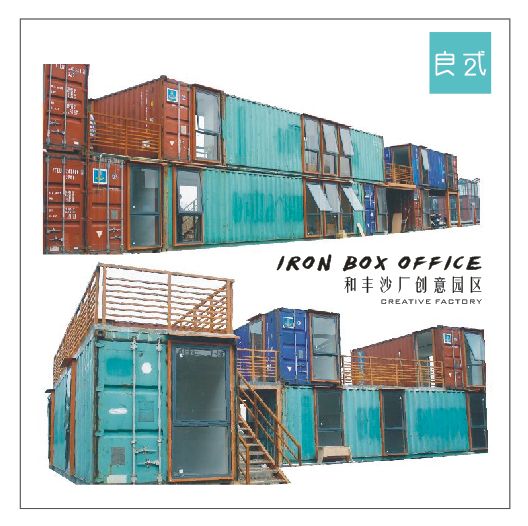
This new creative industry park in Ningbo will be set up in next two years(by using container)
The present situation of creative talents cluster in Ningbo
However, one of the most important elements in creative industry is the creative talents. Demand of creative industry can meet only if the talents gather. Meanwhile, creative talents can be regarded as human capital and also can be explained in cluster (Florida 2008). There are lots of evidences of the advantages of talent agglomeration. As Keane (2008) maintains that talent element plays an important role in creative industry. Ningbo as a second tier city; it should form more activities to attracted professionals. Recently, they try to use higher salary than other big cities in China to attract talents from the world. According to the report from Ningbo Administration of Industry and Commerce. Ningbo has taken part in huge of exhibitions such as China Creative Industry Exhibition etc to promote themselves frequently. On the other hand, Ningbo holds Creative Industry Design Exhibition to raise their prestige. Another approach used by Ningbo government is to training the talents rely on their education system or ask for help from advanced company or nations. At the moment, they decided to anticipate some companies to give technical staff a number of professional trainings to enhancing their knowledge. Until now, they carried out trainings for 4 times for 400 trained staff. (Develop Jiangdong district creative economy 2009). Take example, one of animation companies in Ningbo has signed a contract with Korea Sogang University which provides advanced animation skill to train staff from Ningbo Company’s animation technology (Shen 2007). In addition, Chinese Film Branch at Ningbo Beilun district also sets up a CG College to educate more people move towards animation field (Beilun Development and Reform Bureau 2009). On the other hand, in order to cultivate creative industry talents, some professional educational institutions have provided plenty of majors and course to perfect this industry in Ningbo. For example, Ningbo Institute of Technology-Zhejiang University has established culture and creative industry major. Software Department of Ningbo Dahongying University has opened animation course and corporated with some creative industry parks as well (Yan 2009). Ningbo Engineering Institute starts to enhance the industry design relying on their professional knowledge.
Some problems in Ningbo Creative cluster
As the present situation of creative cluster in Ningbo, Nie&Wang (2008) analyze four aspects of problems that exist in Ningbo creative industry. First one is unbalanced development between business and culture. This problem is embodied on conceptual aspect. Secondly, management confusion, this is a problem belonging to government system. Thirdly, creative industry is lacking of policy to support, such as tax revenues and government grants. Finally, badly lacking in professional designers and mangers.
I would like to add some thought from personal view. The first problem of Ningbo creative clusters is that the position of these creative industry parks is unclear. Most of them share exactly the same function and don’t appear unique character. Every district governments in Ningbo seem to compete with each other. For example, The Third Faison Industry Design Block, Industry Design Street etc have the same functions which are focusing on industry design sector. It is not only causes waste of resources also cut-throat competition due to so many companies at the same level.
And the other problem is that most of existing creative cluster are still in primary stage in Ningbo. Nevertheless, constructing those creative industry parks is just a consciousness. Those creative clusters are short of product chain, industry chain and financing chain. For example, Letu Pottery Studio in Loft 8.Although is the earliest company move into Loft 8, they carry out their first public activity until this year.
Sassen(2001) presents that, the development perspectives of one city and its international prestige determines the national’s power and development space around the world. In the other words, city images could decide the fate of one nation. So that, Ningbo should consider seriously instead of competing with other to develop it own creative industry cluster. Soft power and economy are important function in the process.
Conclusion
In conclusion, Ningbo’s creative cluster shares the same characteristic as the other industry clusters have. However, creative cluster depends on talent factor largely as well as the demand of social capital. Historically, Ningbo is a city with long history in culture. Nowadays, Ningbo is a harbour city international port and well-developed on manufacturing industry. However, these characters and advantages not perform very well in creative industry sector. Therefore, they also restrict further urban development in Ningbo. The positive thing is that, the geography of creative cluster in Ningbo has revealed the general rule. Old factories, old storehouses are located in the old districts, such as Jiangdong district and Haishu district. In addition, High Technology Creative Park is near the university circle due to the resources from these universities. Completely new creative industry parks be located in new district. In this essay, firstly, the environment, culture and government policy in Ningbo were presented. Then, the talent factor was highlighted in Ningbo creative industry. Ningbo government has noticed this problem and tried to corporate with some companies and build some related education system of service for Ningbo’s creative industry. It could be proved that, city’s character should take into consideration and this also determines the city to choose which kind of creative industry. Meanwhile, the function of creative cluster is determined by creative industry of this city. At the end of article, some weakness and thoughts of Ningbo creative industry has been brought forward. It is clear that, Ningbo need to pay huge attention to policy, talent and planning to develop creative industry. Futhermore, the most important thing is that gives up the competition but for do research carefully and use its advantage completely.
References
Bao,Yong 2009, Island Project in Zhoushan, Retrieved 15 May,2009,from http://news.xinmin.cn/rollnews/2009/05/21/1989184.html. 包勇 2009, 舟山连岛工程预计å月底全线贯通, æ¥æºäºŽ2009 5月15æ—¥http://news.xinmin.cn/rollnews/2009/05/21/1989184.html\
Beilun Development and Reform Bureau 2009 , Animation industry in Beilun district. Retrieved 15 May, 2009, from http://www.nbec.gov.cn/newsBrowes/zhengCe/detail.jsp?id=27925北仑区å‘改局 2009, 北仑区动漫产业å‘展åŽåŠ²å足, æ¥æºäºŽ2009å¹´ 5月15http://www.nbec.gov.cn/newsBrowes/zhengCe/detail.jsp?id=27925
Cai,han&Guo,Jian 2008, 30 years culture development in Ningbo,Zhejing People Public Press,Hangzhou. 蔡罕,éƒé‰´ 2008,å®æ³¢æ–‡åŒ–å‘展三å年,浙江人民出版社,æå·ž
Cao,Yanping&Ding,Xiaohong 2008,The first Loft in Ningbo , Retrieved 15 May,2009,from http://news.zj.com/detail/900069.html. 曹燕èå’Œä¸æ™“虹 2008,上世纪的旧厂房å˜æˆå®æ³¢é¦–个LOFT创æ„å›ï¼Œæ¥æºäºŽ2009 5月15æ—¥http://news.zj.com/detail/900069.html
Che, Xiao Fang 2009. Interview, 20 May.
DCMS 2001, Creative Industries Mapping Document 2001, Retrieved 15 May, 2009, from http://www.culture.gov.uk/reference_library/publications/4632.aspx
Develop Jiangdong district creative economy 2009, Retrieved 15 May, 2009, from http://www.nbaic.gov.cn/art/2009/3/24/art_44_11583.html
Florida, R 2008, Who’s Your City? How the Creative Economy Is Making Where You Live the Most Important Decision of Your Life, Random House of Canada, Canada.
Hu, Haizhong & Xiao Yingzhe 2009, ‘On interactive relationship between Ningbo constructing industrial park and developing small-medium scale manufactures’, Journal of Zhejiang Wanli University,vol.22,no.1,pp.83-86.
Keane, M 2008, ‘Creative Clusters: Out of Nowhere?’ Urban China, vol.33,pp.34-35
Keane,M 2009, ‘Great adaptations: China’s creative clusters and the new social contract’, Journal of Media &Cultural Studies,vol.23,no.2,pp.221-230.
Lorenzen,M&Frederiksen,L2007,‘Why do cultural industries cluster? Localization ,urbanization, products and projects.’,in Cooke,H& Lazzeretti,L (eds), Creative cities, cultural clusters and local economic development, Edward Elgar Publishing,UK,pp.155-179.
Maskell, P 2001, Towards a Knowledge-Based Theory of the Geographical Cluster, Industrial and Corporate Change 10(4), pp. 921-943.
Nie, Jinglei& Wang,Qiuyan 2008 The Survey on Current Situation of Creative Industry and Development Stratagem in Ningbo. Journal of Market Modernization,Vol.561, no.12,pp.213-215.
Ningbo overview 2008.Retrieved May 20, 2009, from http://english.ningbo.gov.cn/col/col55/index.html
Sassen,S 2001 ,The global city, Princeton University Press,USA.
Scott, A 2000, The cultural economy of cities, SAGE,London.
Shen,Zaohui 2007 Ningbo cooperate with Korea university for animation industry. Retrieved 15 May, 2009, from http://epaper.cnnb.com.cn/nbrb/20071208/index.html沈æœæ™–2007, 我市引入韩国西江大å¦åŸ¹å…»åŠ¨æ¼«äººæ‰æ¥æºäºŽ2009 å¹´5月15æ—¥http://epaper.cnnb.com.cn/nbrb/20071208/index.html
Van Heur, Bas 2009 ‘The Clustering of Creative Networks: Between Myth and Reality’, Urban Studies 46.9.
Wang,Jici 2006,Some thought about creative clusters, Retrieved 15 May,2009,from http://www.zjol.com.cn/gb/node2/node138665/node257861/node275665/node275666/node275669/userobject15ai3855578.html. 王缉慈2006,创æ„产业集群的价值æ€è€ƒï¼Œæ¥æºäºŽ2009å¹´5月15æ—¥http://www.zjol.com.cn/gb/node2/node138665/node257861/node275665/node275666/node275669/userobject15ai3855578.html\
Yan,Hongfeng 2009,Culture industry in Ningbo Retrieved 18 May, 2009, from http://www.gmw.cn/01gmrb/2009-03/30/content_903173.htm. 严红枫 2009, å®æ³¢ï¼šæ–‡åŒ–产业逆势上扬呈新亮点,æ¥æºäºŽ2009å¹´5月http://www.gmw.cn/01gmrb/2009-03/30/content_903173.htm.
Yao, Pu 2009. Interview, 6 March.
Zhou,Zhao 2008, Ningbo stationery industry in the boom year, Retrieved 15 May,2009,from http://news.brandcn.com/hypp/wj/200811/164235.htmlå‘¨æ˜ 2008 ,å®æ³¢æ–‡å…·äº§ä¸šåœˆçš„崛起åŠå…¶åœ°ä½ ,æ¥æºäºŽ2009 5月15æ—¥http://news.brandcn.com/hypp/wj/200811/164235.html





















Recent Comments